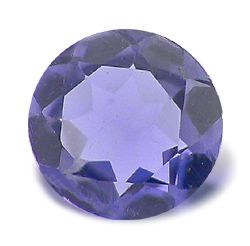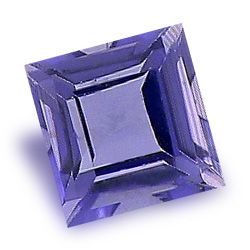 Iolite is a beautiful blue gemstone whose appeal is enhanced by its natural Pleochroism – that is, it reflects light in different colors depending on the angle it’s viewed from. Iolite jewelry is more affordable than its equivalent Sapphire or Tanzanite piece, so it makes a good alternative to someone looking to add a splash of blue to their collection on a limited budget.
Iolite is a beautiful blue gemstone whose appeal is enhanced by its natural Pleochroism – that is, it reflects light in different colors depending on the angle it’s viewed from. Iolite jewelry is more affordable than its equivalent Sapphire or Tanzanite piece, so it makes a good alternative to someone looking to add a splash of blue to their collection on a limited budget.
Can Iolite Jewelry Scratch?
As a relatively ‘hard’ stone based on Moh’s scale of mineral hardness, jewelry with Iolite is unlikely to scratch – so you can easily wear it with other pieces and store it safely in a Jewelry Box. However, as a brittle stone, Iolite will break if knocked in the wrong way. The knock can either create a fracture within the gem, or even break off a chunk! However, if Iolite gems are placed into the right jewelry setting, and handled with care, they are generally hard-wearing and won’t scratch from metals or most other gemstones.
The beautiful blue coloring of Iolite is quite unique. It was once incorrectly termed a “water sapphire”, and it’s easy to see why – the color of this gem is not intense or deep, but a soft, soothing blue. Iolite’s color can often appear to be too dark, suffering from a type of “ink stain” blue that reduces its value. Unlike Sapphires, Iolite gems cannot be heat treated to enhance their color, so the natural hue is as good as it’s going to get!
For the pleochroism characteristic to really shine through, the Iolite gem must be of good clarity. Inclusions are commonly found in larger pieces in the form of spots or milky wisps. As a fragile stone, smaller pieces often show internal cracks, particularly if the gemstone has been mishandled. These cracks can offset the pleochroistic reflections, thereby reducing the value of the gem stone.
Relative to stones such as Sapphires, Iolite is relatively less expensive. So getting a good cut can be done without losing much value via the weight of the stone. The cut of an Iolite gemstone is a very delicate procedure. To retain or improve its value, Iolite must be cut in such a way that enhances its pleochroism and retains its original color. One wrong angle, and both of these characteristics can be lost. Look for a piece of cut Iolite that has strong, properly angled facets. The pleochroism should be clear to see, and the gem should sparkle light directly into your eye.
where is Iolite found?
Large sources of Iolite have been found in Germany, Brazil, Zimbabwe, Sri Lanka, India, Myanmar. In the United States of America, significant deposits have been found in Wyoming. Looking for a gem dealer to buy some iolite? Check out this post – and know your rights before you buy!
 Iolite’s Specific Characteristics
Iolite’s Specific Characteristics
Specific Gravity: 2.58 – 2.66
Chemical Composition: magnesium aluminium silicate
Refractive Index: 1.542 – 1.578
Crystal System: Orthorhombic with short prisms
Hardness (Mohs Scale): 7 -7.5 out of 10
Are Iolite gemstones enhanced or treated?
There are no treatments available to enhance the color or clarity of Iolite, nor are there any common synthetic versions of this gemstone. Despite its affordability, you may still come across Iolite ‘fakes’. These will generally be colored glass, so simply look for depth of color, proper reflection of light, and hardness of the gem to identify the fake stone. Glass is much softer than Iolite, and may already be scratched – a dead give-away!
Iolite is occasionally wrongly labelled as Tanzanite – however, Tanzanite is a softer stone. Iolite is much more affordable, and can be a great substitute if you are looking for a gemstone that has a blue similar to Tanzanite’s beautiful blue but on a budget.
Do Iolite stones have Inclusions?
Pieces of Iolite are often considered imperfect because of inclusions. These are marks inside the gem made by other minerals, or fractures in the stone often caused by mishandling. Look for a gemstone that you can see through that doesn’t have many (if any) inclusions in the form of spots, scratches, or milky lines. The larger the piece of Iolite, the more likely it is that you’ll find inclusions. Large Iolite gemstones with great clarity are highly valuable.
What Color is Iolite gemstone?
A valuable piece of Iolite will have a soft, saturated violet-blue color. Less valuable gems have a faded purple color, and at the lowest end of the scale, Iolite can be nearly white or transparent. The color of Iolite is considered to be quite soft compared to other blue gemstones such as Sapphires.
If the gem is cut correctly, the pleochroism of Iolite will display three different colors of light – light blue, violet blue and a yellow-ish gray.
Iolites vs Blue Sapphire
Although both Iolite and Blue sapphires can sometimes be found in similar colors – Iolite is not a form of sapphire. From a minerology perspective, Iolite is known as Cordierite – and is a different mineral than Sapphires (a form of Corundum). This confusion is generally a result of Iolite being historically called a ‘water sapphire’. (It was used by Vikings in days gone by in determining the direction of the sun on overcast days based its pleochroism – i.e. the play of light on the stone. As such, the price of Iolite is very different (i.e. lower) when compared to a sapphire of equivalent quality,
What is the best cut for Iolite gems?
Cutting Iolite can be a difficult task, and this should only be done by master lapidaries. One wrong cut, and the color of the gemstone can be completely destroyed. A well-cut piece of Iolite will sparkle and direct the light straight into the eye. The angle of the facets should enhance Iolite’s natural pleochromism characteristic so that many colors of light are reflected from within. There should be no dark spots within the gem, or light seeping from the bottom. Angles should be cut straight meeting with each other perfectly, and the facets should be shaped in an aesthetically pleasing manner.
Are large Iolite gemstones common?
Iolate is rarely found in anything larger than 3 carats, but you can occasionally find an affordable piece of up to 5 carats in size. Value is placed heavily on color and clarity of the stone, and most easily-found Iolite gems with these qualities are 3 carats or less.
 Iolite Uses, History & Mythology
Iolite Uses, History & Mythology
Long ago, Iolite’s pleochroism was used to help people understand the angles of light from the sun. By holding a properly cut piece of iolate and examining the colors of the reflected sunlight, Viking sailors were able to determine their location and navigate accordingly.
It is because of this that Iolite gets its reputation as a “guidance” stone. It is said to bring clarity to the wearer about their inner-quest, and can gently steer you in the right direction to fulfill your life purpose.
Aesthetically, Iolite is used in a variety of jewelry settings and is gaining in popularity as an engagement ring stone. It should always be placed in a protective setting and worn with care, as it is very fragile and will easily crack.
In crystal healing, Iolite is said to soothe the emotions and calm a troubled mind. It is gentle, and works on the throat chakra to encourage true expression of the self. Additionally, it is an effective crystal to use with third-eye meditations as it can enhance psychic vision and concentration.
